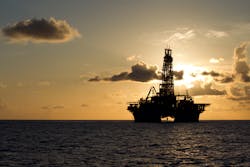Offshore staff
LONDON – Exploration last year held up better than expected, according to a review by Westwood Global Energy Group.
The first half global well count was down by 26% but overall discovered volumes were only 3.5% lower, year on year.
During 2016-2020 high-impact exploration delivered 56 Bboe off discovered resources, with 91 commercial discoveries >100 MMboe. The total proven was 23% lower than in 2011-2015, but from 46% fewer wells.
However, 42% of the volume in 2016-2020 came from 12 discoveries in Russia and Iran: without these countries the overall decrease would be 53%.
Last year 73 high-impact wells were drilled with commercial success rates of 34%. The total discovered resource was 17.7 Bboe, down 3.5% on 2019, with large discoveries off northern Russia at Vikulkovskaya and Ragozinskaya in the South Kara Sea.
Outside of Russia, the largest offshore discoveries were at Tuna in the Turkish sector of the Black Sea, for TPAO, and Kwaskwasi offshore Suriname for APA Corp./Total.
This year, nine of the 10 most active explorers will likely be supermajors or NOCs, said Westwood senior analyst Jamie Collard, with the five supermajors accounting for 29% of high-impact well equity.
More than 50% of emerging play wells planned for 2021 will be offshore Suriname-Guyana. New emerging oil plays will probably be in proven basins and limited in scale, with no significant new oil play discovered since Liza off Guyana in 2015.
Westwood expects 70-90 high-impact exploration wells to be completed in 2021, with activity concentrated in the second half of the year and around 50% of the wells offshore Mexico, Brazil, and Suriname-Guyana.
Wells to watch include Total’s Venus offshore Namibia, Pelles offshore Canada, Cutthroat offshore Brazil and Silverback, currently drilling in the US Gulf of Mexico.
05/27/2021




